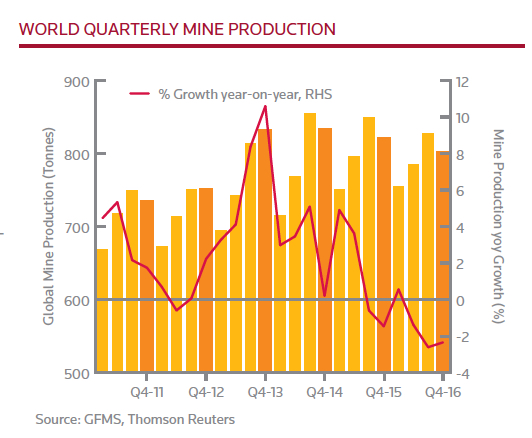
A new report by the GFMS team at Thomson Reuters primary estimates supply of gold continued to ebb lower in the fourth quarter of last year making 2016 the first calendar year of a fall in mine output since 2008.
World gold mine supply fell by 22 tonnes or 3% year-on-year according to the GFMS Gold Survey (registration required), to total 827 tonnes in the third quarter of 2016. GFMS expects mine supply will have contracted in the fourth quarter, with the total estimated at 801 tonnes, a 2% decline year-on-year bring the annual total to 3,168 tonnes.
During the third quarter (most companies have not yet published fourth quarter data) Africa and Oceania are the only two regions that reported year-on-year gains, 6 tonnes and 1 tonne, respectively. Asia reported the biggest year-on-year loss of 15 tonnes for Q3 2016 to 225 total output, driven by top global producer of the metal China.

Source: GFMS Thomson Reuters
There are relatively few new projects and expansions expected to begin producing this year, and those in the near-term pipeline are generally fairly modest in scale, hence our view that global mine supply is set to continue a multi-year downtrend in 2017
[China’s 15 tonne] loss was mainly due to a suspension of operations in some mines in Shandong, Shaanxi and Xinjiang provinces. Stricter safety and environmental regulations were other major reasons behind the 12% year-on-year drop, together with a slowdown across small operations due to permit renewals.
European output declined by 3 tonnes and at 126 tonnes, North America produced 9 tonnes less during the time period with Mexico the main culprit:
Peñasquito saw a four tonne year-on-year decline due to planned lower ore grades, which dropped from 1.08 grammes/tonne for Q3 2015 to 0.69 grammes/tonne for Q3 2016. Output from Cortez was reduced by two tonnes in Q3 2016 compared with Q3 2015, primarily due to lower underground grades as mining is advancing from the high grade Breccia zone to the lower grade Middle zone.
South America produced a total of 139 tonnes of gold in Q3 2016, a three tonne loss compared with Q3 2015 on the back of a mining and processing slowdown at Yanacocha and the depletion of surface stockpiles at Cerro Negro.
Output from Africa rose by six tonnes in the third quarter of 2016 over the same period of 2015, to total 149 tonnes according to the report:
Production from North Mara was increased by one tonne in Q3 2016 driven by a signi cant increase in head grade and improvement in recovery rates. The Sukari mine raised output by one tonne year-on-year for Q3 2016 thanks to 900 satisfactory plant throughput rates, average grades and metallurgical recoveries.
Oceania produced one tonne more in Q3 2016 than a year earlier to total 88 tonnes. Cadia delivered a one tonne year- on-year increase for Q3 2016 as the project continued to ramp up.
The authors of the report pointed out that “there are relatively few new projects and expansions expected to begin producing this year, and those in the near-term pipeline are generally fairly modest in scale, hence our view that global mine supply is set to continue a multi-year downtrend in 2017.”